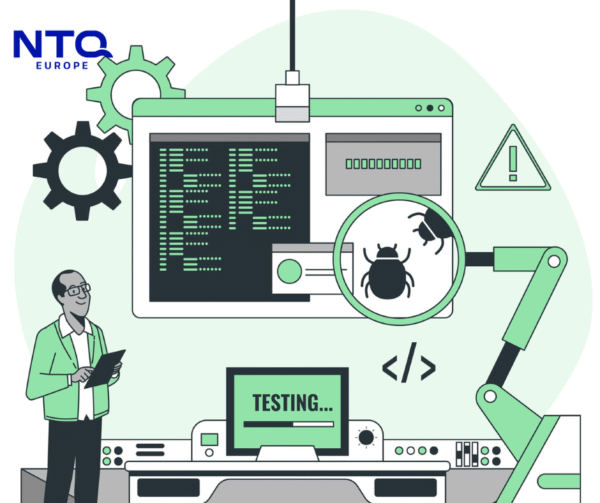1. Understanding Automation Testing Services
What is Automation Testing?
Automation testing is about using smart tools to run tests on your software automatically. Instead of having a person manually go through every test case, these tools follow predefined scripts to check if everything works as expected. They compare actual outcomes with what was predicted and flag any issues, especially useful for repetitive tasks where consistency and speed matter most.
Automated software testing services use advanced tools and workflows to make the entire testing process more efficient and reliable. From writing and running test scripts to managing test data and analyzing results, automation helps ensure your software is stable, high-quality, and ready for release faster and with fewer errors.

Automation testing enables organizations to streamline testing processes, enhance accuracy, and expedite product releases.
Automated Engineering Testing vs. Manual Testing: What’s the Difference and Why It Matters
Businesses often struggle to choose between manual testing and automation testing, or determining how to balance both. While each has its place in the development process, their roles, strengths, and use cases differ significantly.
| Aspect | Manual Testing | Automation Testing |
| Speed | Slower due to human involvement | Much faster; tests run automatically |
| Accuracy | Prone to human error | Highly accurate and consistent |
| Cost Over Time | Lower upfront but more expensive in the long run due to labor hours | Higher upfront cost but more cost-effective over time |
| Reusability | Test cases must be repeated manually | Test scripts can be reused across builds |
| Scalability | Limited scalability | Highly scalable for large and complex systems |
| Best Used For | Exploratory, usability, and one-off tests | Regression, performance, load, and repeated test scenarios |
The Role of Automation Testing in Modern Software Development
As software development becomes faster and more complex, automation testing has shifted from being a nice-to-have to a must-have, helping teams save time while still keeping product quality high even as they scale. In fast-moving Agile and DevOps environments where CI/CD pipelines are the norm, automated testing plays a crucial role as it catches bugs early, validates new code instantly, and helps speed up release cycles without compromising reliability. This kind of real-time feedback helps keep your software stable and reduces the risk of costly issues slipping into production.
Automation also brings consistency and scalability to your QA process. Automated tests run the same way every time, cutting down on human error and increasing coverage, especially in repetitive tasks like regression testing. It also makes collaboration between development and QA teams much smoother by embedding testing right into the workflow, thus making it a strategic advantage for delivering high-quality software, faster and with more confidence.
2. Popular Automation Testing Tools and Frameworks
Leading Automation Testing Tools
Choosing the right tool is a key part of successful automation testing, and the best option often depends on the type of application you’re testing, whether it’s web, mobile, desktop, or API. Here’s a breakdown of leading automation testing tools:
| Tool | Best For | Key Features | Why It Stands Out |
| Selenium | Web application testing | Supports Java, Python, C#, works across all major browsers, CI/CD integration | Open-source, highly customizable, and backed by a strong global community |
| Appium | Mobile app testing (Android & iOS) | Uses familiar programming languages and frameworks, compatible with native, hybrid, and mobile web apps | Open-source and flexible, integrates with cloud platforms for broad device coverage |
| Cypress | Modern front-end web application testing | Runs directly in the browser, provides real-time reloads, interactive debugger, fast execution | Favored by front-end developers for simplicity, speed, and excellent developer experience |
| TestNG/ JUnit | Java-based application testing | Annotation-driven test control, supports unit, functional, and integration tests, parallel execution, rich reporting | Ideal for Java teams needing a structured and scalable testing framework |
Each of these tools plays a unique role in the automation testing ecosystem. The right tool for your project depends on factors like application type, technology stack, team expertise, and integration needs. Many teams even use a combination of these tools to cover different layers of their testing pyramid, ensuring both speed and depth in their quality assurance process.

Automation testing frameworks provide structure and reusability, helping teams manage scripts, test data, and reports efficiently.
Test Automation Frameworks
Automation testing frameworks provide structure and reusability, allowing teams to manage scripts, test data, and reports efficiently. By choosing the right framework, you will gain scalability while reducing maintenance and boosting collaboration across teams.
-
Data-Driven Framework
This setup separates your test data from the test scripts, which means you can run the same script multiple times with different inputs. It’s a smart choice when you need to test lots of variations like apps with form fields, complex calculations, or frequent regression tests.
-
Keyword-Driven Framework
Test actions are stored as keywords in external files, allowing even non-technical team members to build test cases by using a library of predefined actions. This makes it easier for business analysts or testers with limited coding skills to contribute to QA efforts, ideally for teams that include both technical and non-technical contributors.
-
Hybrid Framework
This one combines the strengths of both data- and keyword-driven approaches, offering flexibility and scalability, thus making it a solid option for larger, more complex projects that involve collaboration across different roles. It’s ideal for enterprises looking for long-term maintainability and team-wide collaboration.
-
BDD Framework (e.g., Cucumber)
Behavior-Driven Development frameworks use plain language (like “Given-When-Then”) to define test scenarios, which helps bridge communication between developers, testers, and business stakeholders. It’s especially useful in Agile and DevOps workflows and favored the most by cross-functional teams that value visibility and alignment across departments.
-
Specialized Use Case: Robotics Industry
In technical fields like robotics, automation testing isn’t just about software as it needs to simulate and validate real-world robotic actions. Frameworks here are designed to integrate with hardware systems, provide real-time feedback, and ensure accuracy.

Automation testing brings significant advantages to modern software development
Integrating Automation Testing into CI/CD
Bringing automation testing into your CI/CD pipeline is a must for modern software development. Instead of discovering bugs at the end of a sprint, automated tests run every time new code is committed, helping your team get immediate feedback, catch issues early, and keep faulty code from slipping through. It’s a great way to keep developers, testers, and DevOps teams aligned while maintaining high-quality standards, even as release cycles speed up.
With tools like Jenkins, GitLab CI, or CircleCI, you can automatically trigger test scripts built with frameworks like Selenium, TestNG, or Cypress. These tools make sure new changes don’t break existing functionality well before anything goes live. By embedding testing into your daily workflow, you’ll ship updates faster with more confidence and fewer last-minute fire drills.
3. Benefits of Automation Testing
Automation testing brings significant advantages to modern software development, helping teams move faster, catch bugs earlier, and maintain high-quality standards.
Faster Testing, Higher Accuracy
Automation allows tests to run much faster than manual efforts, especially when executing repetitive tasks like login checks or form submissions, leading to fewer errors and more consistent results. This is essential when you need to test frequently and get reliable feedback fast, whether you’re releasing weekly or daily.
Lower Long-Term Costs, Better Efficiency
While automation testing requires an upfront investment in tools and setup, it pays off quickly. Once your test scripts are in place, they can be reused across multiple builds and environments, saving hundreds of hours in manual effort. This improved efficiency reduces QA costs and allows your team to focus on more strategic tasks like exploratory testing or usability reviews.
Easier Regression Testing, Stronger Product Quality
Every time you update your codebase, you risk breaking something that was working before. Automated regression testing helps catch those bugs early by quickly re-checking all core functionalities after every change. This ensures stability and protects the user experience, helping your product maintain high standards as it evolves.

Automation testing brings long-term efficiency and accuracy
4. Challenges in Automation Testing
While automation testing brings long-term efficiency and accuracy, getting it right from the start comes with a few real-world hurdles.
Choosing the Right Tool for Your Project
With a wide range of tools and frameworks available like Selenium, Cypress, Appium, and TestNG, it can be difficult to pick one that truly fits your tech stack, team skills, and testing needs. Choosing the wrong tool can lead to unnecessary complexity, poor performance, or even the need to start over later because what works for a web app may not be ideal for mobile or desktop testing. The key is to consider your application’s architecture, team capabilities, and long-term goals before investing in a specific tool.
High Upfront Investment & Test Script Maintenance
While automation saves time in the long run, the initial setup, including writing test scripts, configuring environments, and training staff, requires significant time and resources. Once scripts are written, they must be maintained as the software evolves, even small changes to the UI or business logic can cause tests to break. Without regular updates, your test suite might become unreliable, leading to the need of planning for long-term script maintenance.
Testing Complex UIs Across Multiple Platforms
UI testing can get tricky fast, especially when you’re working with dynamic interfaces which are things like animations, live data, or pop-ups. Now throw in multiple browsers, different devices, and screen sizes, and you’ve got a real challenge. Making sure everything works smoothly across the board takes a solid automation strategy and the right tools, and it also means writing detailed, adaptable scripts that can handle changes gracefully. It’s not easy but with the right setup, you’ll ensure a better user experience across every platform your product supports.
5. When to Implement Automation Testing
Knowing when to adopt automation testing is as important as knowing how. While automation brings efficiency and scalability, it’s not the right fit for every testing scenario. You should consider automation testing when:
When You Need Frequent Regression Testing
If your development team is releasing updates regularly whether weekly, bi-weekly, or even daily, manual testing can quickly become a bottleneck. Automation is perfect for automated regression testing, where you need to constantly re-check existing features to make sure new code doesn’t break anything. By automating these repetitive checks, teams save time and ensure stable releases.
When You’re Working on Large-Scale or Long-Term Projects
Bigger applications with multiple modules, user roles, and complex workflows benefit significantly from automation as the product grows, the test coverage needed grows too. Automation allows teams to scale their testing efforts without exponentially increasing QA headcount or time, ensuring consistency across builds and helping catch issues that may slip through manual checks.
When You’re Adopting Agile or DevOps Practices
In Agile and DevOps workflows, speed and continuous delivery are very important. Automation testing fits naturally into these models by offering fast, repeatable, and reliable testing that can be triggered automatically in CI/CD pipelines, which provides real-time feedback on code quality, reduces time-to-market, and supports test-driven development.

Automation testing stands as a cornerstone in modern software development, offering speed, accuracy, and efficiency.
6. Why NTQ Europe Is Your Trusted Automation Testing Partner
Automation testing is a strategic advantage we build into every project. At NTQ Europe, we combine deep technical expertise with a practical, business-driven mindset to help clients around the world release better software, faster. Whether you’re scaling a digital platform, modernizing legacy systems, or building something entirely new, our automation-first approach ensures you stay ahead in a competitive market.
Tailored Automation for Your Tech and Business Goals
We don’t offer generic solutions. Every automation strategy we build is carefully aligned with your product, tech stack, and development workflow. From selecting the right tools like Selenium, Appium, or Cypress, to designing test architecture, we ensure testing supports your delivery process.
End-to-End QA Support, Not Just Test Scripts
Our Software QA & Testing service goes far beyond writing test cases. We help you plan, design, and maintain a complete testing strategy from defining KPIs to post-release monitoring. Our QA engineers work alongside your development teams to make testing seamless, efficient, and accurate at every stage.
DevOps-Ready Integration for Faster Releases
With deep experience in Agile and DevOps, our team builds automated regression testing workflows that integrate smoothly into your CI/CD pipelines. This means real-time feedback, fewer production bugs, and a faster time-to-market every time you ship.
Deep Industry Experience and Multinational Mindset
With delivery centers in both Vietnam and Europe, we bring global insight and local execution together. We understand the quality expectations of European markets and the speed required in Asia-Pacific product life cycles. Our teams are fluent in Agile collaboration, time zone coordination, and cross-cultural communication, making us a natural partner for companies scaling internationally.
Proven Results for Global Clients
We’ve helped fintech startups cut testing time by 40%, enabled SaaS platforms to reduce release cycles from monthly to weekly, and built fully automated frameworks for enterprise clients handling millions of users. Our success isn’t just in automation; it’s in helping your software perform reliably where it matters most: with real users.
7. Accelerate Your Business Growth Today With Automation Testing
Automation testing has become a game-changer in today’s fast-paced software world as it brings the speed, precision, and consistency that teams need to deliver high-quality products quickly and confidently. By weaving automated testing into your development process, you’re ensuring smoother releases, fewer bugs, and a stronger position in the market.
Want to make testing your advantage, not your bottleneck? Let’s make it happen together.



















